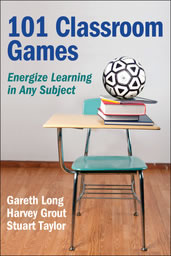|
101
CLASSROOM GAMES: ENERGIZE LEARNING IN
ANY SUBJECT
media review written by
Peter
Rattigan
 Target
Audience/Purpose: Target
Audience/Purpose:
This book was written for teachers as
a way of providing game based review for
almost any subject, including but certainly
not limited to health and physical education.
The authors provide 101 games that can
be used as more interesting, creative,
exciting/ motivating ways for students
to review content or exam materials.
Content:
The authors explain the purpose of their
book in the one page preface. The rest
of the book contains the 101 classroom
games, in alphabetical order by name of
the game. Each game has the same descriptive
format, namely a title, brief purpose
statement, list of materials needed, full
game description, and variations. Two
variations are provided for every game:
an "easier" variation and a
"harder" variation.
The games are all different. Some are
based on board games ("Pin The Tail
On The…," "Snakes &
Ladders"). Some are based on TV game
shows ("Phone a Friend," "Strike
a Deal [Deal Or No Deal]"). Many
are based on sports such as basketball,
bowling, cricket, golf and tennis.
Typically these latter games are based
on some element of the sport, such as
tennis scoring, that is a paper/pencil
version of the sport. Many of the games
require little equipment (other than questions
or review materials, which the teacher
or students may already have), and some
require little or no equipment at all
("I Am Not," "Stand To
Attention," "Word Rebounds").
On the other hand, a few require considerable
preparation and equipment ("Make
It, Draw It or Mime It," "Which
Way is Best?"). Although often based
on sport themes, many of the games are
relatively inactive in terms of physical
movement. However, some are quite active
("River Crossing," "Stand
Up and Be Counted"), and some require
moving tables and/or chairs ("Quizzical
Chairs," "Step Up to the Challenge").
101
Classroom Games: Energize Learning
in Any Subject
ISBN/DOI: 0-7360-9150-1
Complete Reference:
Long, G., Grout, H., & Taylor,
S. (2011). 101 Classroom Games:
Energize Learning in Any Subject.
Champaign, IL: Human Kinetics
Publishing Company: Human Kinetics
Authors: Gareth
Long, Harvey Grout & Stuart
Taylor
Reviewer: Peter
Rattigan |
Since the authors are from the UK, there
are some interesting differences in terminology.
For example, students are referred to
as "pupils." Some common items
may not be recognized - for example, the
"Smarties" in "Who Wants
to Be A Smartie" refers to Smarties
candy.
Strengths/ Limitations:
The strength of this book is in the variety
of activities and the clarity/brevity
of description. There are enough games
in this book for teachers, especially
at the secondary level, to make all their
review classes exciting, interesting and
motivating. The layout for each activity
and the game descriptions make them easy
to understand and apply. The variations
provide for either differentiation in
the review, or for modifications for younger/refinements
for older students. In addition, there
are diagrams, score sheets, and other
materials that teachers can use either
as is, or as templates for creating their
own materials for the games. Any of the
games can be modified, and the authors
encourage this, with the request that
modifications be sent to them at their
web site.
There are some ways in which the book
could be improved. First, there are some
elimination games ("Quizzical Chairs"
for example). However, these can usually
easily be modified to exclude elimination.
Second, as easy as the games are to understand,
they are hard to find/review quickly as
they are organized based on name. The
games could be organized, for example,
by category or type (activity level, material
needs, topical areas for example). Alternatively,
the order could remain the same, but a
glossary/index at the back of the book
could help readers/users to quickly look
up games by logical category.
Summary:
This is a text almost all teachers should
have on their bookshelf. The games are
varied, interesting, and engaging for
both student and teacher. They are easy
to understand. Some may require a fair
amount of preparation, but others can
be done with minimal preparation, even
as last minute emergency activities (for
example, for physical educators who lose
the use of their gymnasium, or for classroom
teachers experiencing technical problems
with media or for some reason cannot do
their prepared lesson). I tried several
of the games with my college students
and found them easy both to implement
and to modify, even on the fly.
Recommendation:
There are few teachers for whom this book
would not be appropriate. Some of the
activities may be less suitable for younger
elementary age levels, but many could
be conducted with younger students or
modified for that audience. Some subjects,
such as art, may lend themselves less
easily to these types of activity (even
here, art history could be appropriate).
While the key audience would appear to
be K-12, especially secondary levels,
most activities would work with college
students also. I aim to use, or modify
and use, many of these activities to engage
my college students (teacher candidates)
in active, exciting and engaging content
review, and as illustrations of instructional
strategies they can adopt in their own
teaching in the future.
Reviewer:
Peter
Rattigan, PhD.
Associate Professor
Rowan University
Glassboro, NJ
|



